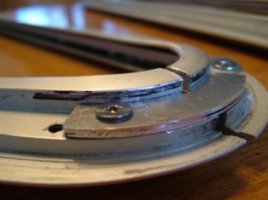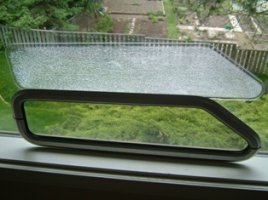A year ago I had to postpone this project due to a catastrophic knee injurry. Well, the MCL is better than new, the ACL has been replaced, the cartilage trimmed, I'm rehabbed and got onto finally doing the project. The two fixed ports on the port side are out, the frames are apart, the glass shop is cutting lexan for all four ports to fit, and I will re-assemble the the two I took out and install them on the boat this weekend. I'll take out the starboard ports then and do them as well.
It wasn't that bad. The trick was getting the upper half of each port to separate from the lower half. They are held together by closely fitted pieces of plastic inside the aluminium window frame extending about an inch into the top and bottom half at the joint. The plastic is held in place inside the frame by four deep punch depressions forcing the aluminium frame material into recesses in the plastic fitting. Two punch marks on top, two on the bottom. I drilled these punch mark depressions out of the top half of the port with a drill bit big enough to remove the entire punch mark depression and very carefully took the ports apart. This is the only difficult part. I used two strong steel scrapers placed against the aluminium frame on either side of the little rubber spacer and then levered between the two scrapers with a big screwdriver. The straight sides of the frame came apart easily. On the curved ends, the spacer broke at the first punch mark. I solved that by making a fitting out of one-eighth inch flat aluminum that I screwed onto the flat inside of the curved end of the port. There is enough room.
So far, so good. I'll have my wife take pictures of the various steps involved as I do the last two ports.
It wasn't that bad. The trick was getting the upper half of each port to separate from the lower half. They are held together by closely fitted pieces of plastic inside the aluminium window frame extending about an inch into the top and bottom half at the joint. The plastic is held in place inside the frame by four deep punch depressions forcing the aluminium frame material into recesses in the plastic fitting. Two punch marks on top, two on the bottom. I drilled these punch mark depressions out of the top half of the port with a drill bit big enough to remove the entire punch mark depression and very carefully took the ports apart. This is the only difficult part. I used two strong steel scrapers placed against the aluminium frame on either side of the little rubber spacer and then levered between the two scrapers with a big screwdriver. The straight sides of the frame came apart easily. On the curved ends, the spacer broke at the first punch mark. I solved that by making a fitting out of one-eighth inch flat aluminum that I screwed onto the flat inside of the curved end of the port. There is enough room.
So far, so good. I'll have my wife take pictures of the various steps involved as I do the last two ports.







 .
.